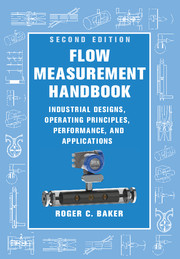Book contents
- Frontmatter
- Dedication
- Contents
- Preface
- Acknowledgements
- Nomenclature
- 1 Introduction
- 2 Fluid Mechanics Essentials
- 3 Specification, Selection and Audit
- 4 Calibration
- 5 Orifice Plate Meters
- 6 Venturi Meter and Standard Nozzles
- 7 Critical Flow Venturi Nozzle
- 8 Other Momentum-Sensing Meters
- 9 Positive Displacement Flowmeters
- 10 Turbine and Related Flowmeters
- 11 Vortex Shedding, Swirl and Fluidic Flowmeters
- 12 Electromagnetic Flowmeters
- 13 Magnetic Resonance Flowmeters
- 14 Ultrasonic Flowmeters
- 15 Acoustic and Sonar Flowmeters
- 16 Mass Flow Measurement Using Multiple Sensors for Single-Phase Flows
- 17 Multiphase Flowmeters 508
- 18 Thermal Flowmeters
- 19 Angular Momentum Devices
- 20 Coriolis Flowmeters
- 21 Probes for Local Velocity Measurement in Liquids and Gases
- 22 Verification and In Situ Methods for Checking Calibration
- 23 Remote Data Access Systems
- 24 Final Considerations
- References
- Main Index
- Flowmeter Index
- Flowmeter Application Index
17 - Multiphase Flowmeters 508
Published online by Cambridge University Press: 05 August 2016
- Frontmatter
- Dedication
- Contents
- Preface
- Acknowledgements
- Nomenclature
- 1 Introduction
- 2 Fluid Mechanics Essentials
- 3 Specification, Selection and Audit
- 4 Calibration
- 5 Orifice Plate Meters
- 6 Venturi Meter and Standard Nozzles
- 7 Critical Flow Venturi Nozzle
- 8 Other Momentum-Sensing Meters
- 9 Positive Displacement Flowmeters
- 10 Turbine and Related Flowmeters
- 11 Vortex Shedding, Swirl and Fluidic Flowmeters
- 12 Electromagnetic Flowmeters
- 13 Magnetic Resonance Flowmeters
- 14 Ultrasonic Flowmeters
- 15 Acoustic and Sonar Flowmeters
- 16 Mass Flow Measurement Using Multiple Sensors for Single-Phase Flows
- 17 Multiphase Flowmeters 508
- 18 Thermal Flowmeters
- 19 Angular Momentum Devices
- 20 Coriolis Flowmeters
- 21 Probes for Local Velocity Measurement in Liquids and Gases
- 22 Verification and In Situ Methods for Checking Calibration
- 23 Remote Data Access Systems
- 24 Final Considerations
- References
- Main Index
- Flowmeter Index
- Flowmeter Application Index
Summary
Introduction
The measurement of mass flow of multiphase fluids is likely to range across wide industry areas as diverse as food processing and subsea hydrocarbon extraction, but at present the technology appears mainly to be driven by the petrochemical industry.
The measurement also needs to take account of flows where the nature of the second component may or may not be known, and the proportions or indeed the existence of the second or even third component may not be known.
I am very conscious that others are more knowledgeable on multiphase flowmeters than I, and it is not appropriate to attempt to duplicate their published work on the subject. This is, therefore, a brief view of this important industrial area and a review of some published literature of which I am aware including some early references, together with pointers to key specialist books on the subject.
Some of the earliest data appear to be related to nuclear plants under emergency conditions. Extensive experiments were undertaken, and special designs and combinations of meter were tried in order to obtain a system which would signal fault conditions in the nuclear reactor duct flows (e.g. Baker 1977; Baker and Saunders 1977 in relation to sodium flows in fast breeder reactors). Some applications of traditional flowmeters to two/multiphase flows may be found in the chapters of this book specific to those meters.
Dykesteen (1992) identified the development of small oil wells in the North Sea where a platform to support a separator would be too costly as one reason for needing a compact and subsea multiphase meter. Subsea reservoir management needs to take place without the use of a separator, and where different satellite wells are operated under different licences, individual flow measurement will be required. The multiphase meter should, if possible, provide component fractions, component velocities and component densities.
An attempt was made (Baker 1991a) to draw together the references and the most useful data on the likely response of bulk flowmeters when placed in such flows (cf. Baker 1988b, 1989). Subsequently Whitaker (1993) reviewed further developments. In this chapter I have attempted to draw together more recent published work of which I am aware, but would particularly recommend to readers that they obtain one of the recent books specifically on multiphase flow measurement, for instance Falcone, Hewitt and Alimonti (2009), Schlumberger (2010) or Corneliussen et al. (2005).
- Type
- Chapter
- Information
- Flow Measurement HandbookIndustrial Designs, Operating Principles, Performance, and Applications, pp. 508 - 529Publisher: Cambridge University PressPrint publication year: 2016



